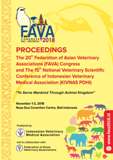AQ-4 Desinfection of Conveyance Using Bacteria Model (Bacillus Subtillis & Bacillus Cereus)
Abstract
Indonesia is an agricultural country consisting of 17,504 islands, each of which has different biodiversity potentials. Increase in trade traffic today supported by the modernization of a fast-paced and sophisticated transpotation tool enables the spread of quarantine animal diseases from abroad into Indonesia, or across Indonesia.A conveyance means used to transport animals or livestock from one area to another. This conveyance means in direct contact with the animals brought. The conveyance has the potential to transmit the disease from one animal to another and from one area to another. Animal transport means can be sea ships, cars, box cars, trucks, baskets etc.
Reducing the potential of disease transmission carried by conveyance, quarantine action is required on the means of conveyance. One of the measures against conveyance is disinfection. Disinfection is a process of reducing the number of disease-causing or potentially pathogenic microorganisms by physical and chemical. Disinfection is done using a variety of disinfectants that are easy to find and easy to use. The types of disinfectants commonly used in disinfection are iodine, alcohol, ammonium quartener, formaldehyde, potassium permanganate, phenol.
With this test, it is expected to get the type and effective disinfectant concentration to kill pathogenic microorganisms so that animal diseases transmission from transportation can be minimized.
To determine the type and concentration of effective disinfectants to kill pathogenic microorganisms especially spores that can be transmitted through a variety of conveyances.

